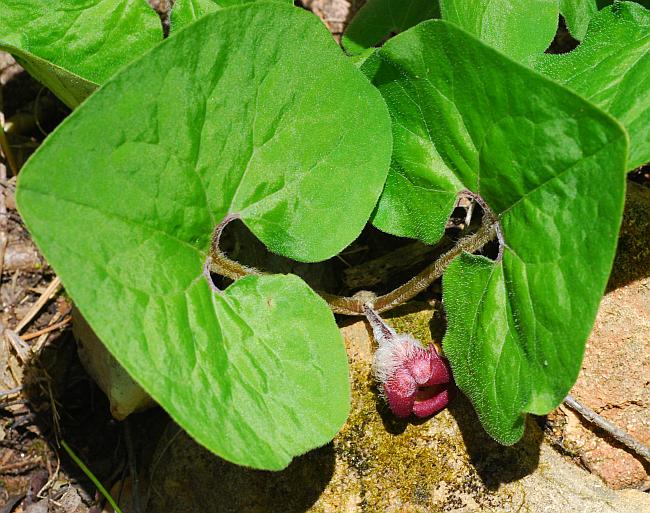Asarum canadense L.
Wild Ginger

Native
CC = 6
CW = 3
MOC = 79
© SRTurner
Asarum canadense L.Wild Ginger | |
 |
Native CC = 6 CW = 3 MOC = 79 |
© SRTurner |
|
Family - Aristolochiaceae Habit - Perennial forb, colonial with widely creeping, often branched rhizomes. Stems - Aerial stems absent.
Leaves - Simple, entire, petiolate, paired at the tips of rhizome branches. Petiole to 20 cm long, hairy. Leaf blade 4-15 cm long, broadly kidney-shaped to nearly circular in outline, rounded at the tip, deeply cordate at the base, hairy, the upper surface sometimes sparsely so.
Flowers - Solitary at the rhizome tips, borne at or near ground level, with a stalk 1-5 cm long, appearing attached between the leaves, actinomorphic. Calyx deeply 3-lobed, usually densely hairy, the tube absent or very short and straight, the lobes 6-24 mm long, narrowly ovate-triangular, erect and slightly overlapping toward the base (appearing tubular), the tips spreading to recurved, narrowed or long-tapered to a point, purplish brown to maroon, the inner surface usually with a well-defined white to light green basal region, sometimes spotted or mottled with purple, the outer surface often tan toward the base. Petals absent. Stamens 12, the filaments distinct but often appressed to the style, the anthers with a minute, sharply pointed, sterile extension between the pollen sacs. Ovary with 6 locules. Stigmas 6, globose or nearly so.
Fruits - Casules, globose to barrel-shaped, somewhat fleshy, dehiscing irregularly, the calyx persistent. Seeds 3.5-4.5 mm long, concave and with a longitudinal ridge on one side, rounded on the other, ovate in outline, olive green to greenish brown, the surface wrinkled, the ridge with a fleshy caruncle toward the end.
Flowering - April - May. Habitat - Bottomland or mesic forests, streambanks, bases of bluffs. Origin - Native to the U.S. Lookalikes - None close. Other info. - This plant is common in rich, moist woodlands throughout most of Missouri, as well as most of the Midwest and northeastern U.S. It is easy to identify, forming low colonies of rounded leaves with distinctly cordate bases. It blooms reliably, and in springtime the maroon flowers can almost always be found at ground level, around the bases of the plants. Photographs taken in Victoria Glade Conservation Area (wooded areas), Jefferson County, MO, 4-24-2009, Emmenegger Nature Park, St. Louis County, MO, 5-21-2011, and Shaw Nature Reserve, Franklin County, MO, 5-8-2014 (SRTurner). |